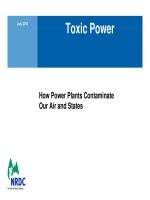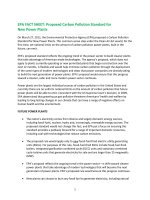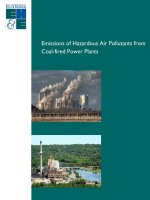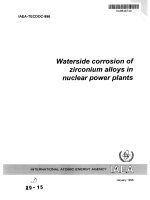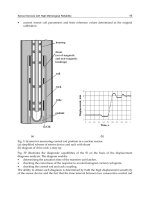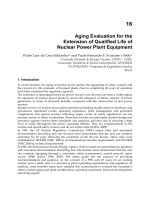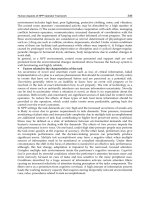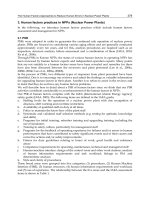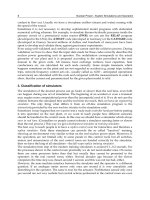NUCLEAR POWER PLANTS pot
Bạn đang xem bản rút gọn của tài liệu. Xem và tải ngay bản đầy đủ của tài liệu tại đây (24.74 MB, 350 trang )
NUCLEAR POWER PLANTS
Edited by Soon Heung Chang
Nuclear Power Plants
Edited by Soon Heung Chang
Published by InTech
Janeza Trdine 9, 51000 Rijeka, Croatia
Copyright © 2012 InTech
All chapters are Open Access distributed under the Creative Commons Attribution 3.0
license, which allows users to download, copy and build upon published articles even for
commercial purposes, as long as the author and publisher are properly credited, which
ensures maximum dissemination and a wider impact of our publications. After this work
has been published by InTech, authors have the right to republish it, in whole or part, in
any publication of which they are the author, and to make other personal use of the
work. Any republication, referencing or personal use of the work must explicitly identify
the original source.
As for readers, this license allows users to download, copy and build upon published
chapters even for commercial purposes, as long as the author and publisher are properly
credited, which ensures maximum dissemination and a wider impact of our publications.
Notice
Statements and opinions expressed in the chapters are these of the individual contributors
and not necessarily those of the editors or publisher. No responsibility is accepted for the
accuracy of information contained in the published chapters. The publisher assumes no
responsibility for any damage or injury to persons or property arising out of the use of any
materials, instructions, methods or ideas contained in the book.
Publishing Process Manager Sandra Bakic
Technical Editor Teodora Smiljanic
Cover Designer InTech Design Team
First published March, 2012
Printed in Croatia
A free online edition of this book is available at www.intechopen.com
Additional hard copies can be obtained from
Nuclear Power Plants, Edited by Soon Heung Chang
p. cm.
ISBN 978-953-51-0408-7
Contents
Preface IX
Chapter 1 Analysis of Emergency Planning Zones
in Relation to Probabilistic Risk Assessment
and Economic Optimization for International
Reactor Innovative and Secure 1
Robertas Alzbutas, Egidijus Norvaisa and Andrea Maioli
Chapter 2 Evolved Fuzzy Control System for a Steam Generator 19
Daniela Hossu, Ioana Făgărăşan,
Andrei Hossu and Sergiu Stelian Iliescu
Chapter 3 Deterministic Analysis of Beyond Design
Basis Accidents in RBMK Reactors 37
Eugenijus Uspuras and Algirdas Kaliatka
Chapter 4 Cross-Flow-Induced-Vibrations
in Heat Exchanger Tube Bundles: A Review 71
Shahab Khushnood, Zaffar Muhammad Khan,
Muhammad Afzaal Malik, Zafarullah Koreshi,
Muhammad Akram Javaid, Mahmood Anwer Khan,
Arshad Hussain Qureshi, Luqman Ahmad Nizam,
Khawaja Sajid Bashir, Syed Zahid Hussain
Chapter 5 The Gap Measurement Technology
and Advanced RVI Installation Method
for Construction Period Reduction of a PWR 129
Do-Young Ko
Chapter 6 Strategic Environmental Considerations
of Nuclear Power 161
Branko Kontić
Chapter 7 Investigation on Two-Phase Flow Characteristics
in Nuclear Power Equipment 185
Lu Guangyao, Ren Junsheng, Huang Wenyou,
Xiang Wenyuan, Zhang Chengang and Lv Yonghong
VI Contents
Chapter 8 Analysis of Primary/Containment Coupling
Phenomena Characterizing the MASLWR Design
During a SBLOCA Scenario 203
Fulvio Mascari, Giuseppe Vella, Brian G. Woods,
Kent Welter and Francesco D’Auria
Chapter 9 Radiobiological Characterization Environment
Around Object "Shelter" 231
Rashydov Namik,
Kliuchnikov Olexander, Seniuk Olga,
Gorovyy Leontiy, Zhidkov Alexander, Ribalka Valeriy,
Berezhna Valentyna, Bilko Nadiya, Sakada Volodimir, Bilko Denis,
Borbuliak Irina, Kovalev Vasiliy, Krul Mikola and Georgy Petelin
Chapter 10 Radiochemical Separation of Nickel for
59
Ni and
63
Ni
Activity Determination in Nuclear Waste Samples 279
Aluísio Sousa Reis, Júnior, Eliane S. C. Temba,
Geraldo F. Kastner and Roberto P. G. Monteiro
Chapter 11 AREVA Fatigue Concept – A Three Stage Approach to
the Fatigue Assessment of Power Plant Components 293
Jürgen Rudolph, Steffen Bergholz,
Benedikt Heinz and Benoit Jouan
Chapter 12 Phase Composition Study of Corrosion Products at NPP 317
V. Slugen, J. Lipka, J. Dekan, J. Degmova and I. Toth
Preface
Book Nuclear Power Plants, covers various topics, from thermal-hydraulic analysis to
the safety analysis of nuclear power plant, written by more than 30 authors. It does not
focus only on current power plant issues. Instead, it aims to address the challenging
ideas that can be implemented in and used for the development of future nuclear
power plants. This book will take the readers into the world of innovative research
and development of future plants. Find your interests inside this book!
Dr. Soon Heung Chang,
KAIST Department of Nuclear & Quantum Engineering,
South Korea
1
Analysis of Emergency Planning Zones in
Relation to Probabilistic Risk Assessment
and Economic Optimization for International
Reactor Innovative and Secure
Robertas Alzbutas
1,2
, Egidijus Norvaisa
1
and Andrea Maioli
3
1
Lithuanian Energy Institute
2
Kaunas University of Technology
3
Westinghouse Electric Company
1,2
Lithuania
3
USA
1. Introduction
Probabilistic Risk Assessment (PRA) tehniques applied to the definition of Emergency
Planning Zone (EPZ) have not reached the same level of maturity when dealing with
external events as PRA methodologies related only to internal events (Alzbutas et al., 2005).
This is even of greater importance and relevance when PRA is used in the design phase of
new reactors (IAEA-TECDOC-1511, 2006; IAEA-SSG-3, 2010; IAEA-SSG-4, 2010).
The design of the layout of a Nuclear Power Plant (NPP) within its identified site, with the
arrangement of its structures, as well as the definition of the EPZ around the site can be used
to maximise the plant safety related functions, thus further protecting nearby population
and environment. In this regard, the design basis for NPP and site is deeply related to the
effects of any postulated internal and external hazardous event and the possibilities of the
reactor to cope with related accidents (i.e., to perform the plant safety related functions).
Among the objectives for advanced reactors there is the aim to establish such a higher safety
level with improved design characteristics that would justify and enable revised emergency
planning requirements. While providing at least the same level of protection to the public as
the current regulations, ideally, but still not realistically, the total elimination of hazards’
consequences would result in the EPZ coincidinge with the site boundary, thus, there would
be no need for off-site evacuation planning, and the NPP would be perceived as any other
industrial enterprise.
In this chapter, the International Reactor Innovative and Secure (IRIS) is adopted as a prime
example of an advanced reactor with enhanced safety. The IRIS plant (Carelli, 2003, 2004,
2005) used a Safety-by-Design™ philosophy and such that its design features significantly
reduced the probability and consequences of major hazardous events. In the Safety-by-
Design™ approach, the PRA played a key role; therefore a Preliminary IRIS PRA had been
Nuclear Power Plants
2
developed along with the design, in an iterative fashion (Kling et al., 2005). This
unprecedented application of the PRA techniques in the initial design phase of a reactor was
also extended to the external event with the aim of reviewing the EPZ definition. To achieve
this particular focus was dedicated to PRA and Balance Of Plant (BOP).
For the design and pre-licensing process of IRIS, the external events analysis included both
qualitative evaluation and quantitative assessment. As a result of preliminary qualitative
evaluation, the external events that had been chosen for more detailed quantitative
assessment were as follows: high winds and tornadoes, aircraft crash and seismic activity
(Alzbutas et al., 2005, Alzbutas & Maioli, 2008).
In general, the analysis of external events with related bounding site characteristics can
also be used in order to optimize the potential future restrictions on plant siting and risk
zoning. Due to this and Safety-by-Design™ approach, IRIS, apart from being a
representative of innovative and advanced reactors, had the necessary prerequisite, (i.e.,
excellent safety), for attempting a redefinition of EPZ specification criteria, IRIS was
therefore used as a test-bed.
The work presented in this chapter was performed within the scope of activities defined
by the International Atomic Energy Agency (IAEA) Co-ordinated Research Project (CRP)
on Small Reactors with no or infrequent on-site refuelling. Specifically, it was relevant to
“Definition of the scope of requirements and broader specifications” with respect to its
ultimate objective (revised evacuation requirements), and to “Identification of
requirements and broader specifications for NPPs for selected representative regions”
considering specific impact on countries with colder climate and increased interest for
district heating co-generation.
The economic modelling and optimization presented in the second part of the chapter was
concentrating on the evaluation of possibilities to construct a new energy source for
Lithuania. The MESSAGE modelling tool was used for modelling and optimization of the
future energy system development (IAEA MESSAGE, 2003). In this study, the introduced
approach was applied focusing on Small and Medium nuclear Reactor (SMR), which was
considered as one of the future options in Lithuania. As an example of SMR, the IRIS
nuclear reactor was chosen in this analysis.
If IRIS with reduced EPZ could be built near the cities with a big heat demand is, it could be
used not only for electricity generation, but also for heat supply for residential and
industrial consumers. This would allow not only to reduce energy prices but also to
decrease fossil fuel consumption and greenhouse gas emissions.
Finally, the analysis of uncertainty and sensitivity enabled to investigate how uncertain
were results of this modelling and how they were sensitive to the uncertainty of model
parameters (Alzbutas et al, 2001).
In summary, the study presented in this chapter consists of two main parts: the analysis of
EPZ in relation to PRA with focus on external events, and the economic optimization of
future energy system development scenarios with focus on sensitivity and uncertainty
analysis in relation to initial model parameters. The study explicitly uses features of IRIS
technology and a potentially reduced EPZ.
Analysis of Emergency Planning Zones in Relation to Probabilistic Risk
Assessment and Economic Optimization for International Reactor Innovative and Secure
3
2. Approach used for IRIS
2.1 Safety-by-Design™ concept
The IRIS designers used the Safety-by-Design™ philosophy from its inception in 1999. Such
a designing approach had been outlined in detail in previous works (Carelli, 2005), (Carelli,
2004); here it is suffice to remember that the key idea of the Safety-by-Design™ concept is to
physically eliminate the possibility of occurrence or to reduce consequences of accidents,
rather than focusing only on the mitigation phase.
The most evident implication of this design approach is the choice of an integral reactor
configuration, where the integral reactor vessel (containing eight internal steam generators
and reactor coolant pumps) and the internal control rod drive mechanism were introduced
causing the consequential absence of large primary pipes. Such a configuration enabled to
have either eliminated major design basis events such as Large Break LOCA (loss-of-coolant
accident) or rod ejection and also to have significantly reduced the consequences of them.
This Safety-by-Design™ approach was used by the designers of IRIS to eliminate the
possibility of occurrence of certain severe accidents caused by internal events and have been
extended to the external events. The focus was on the balance of plant that had not been
analyzed as extensively or explicitly as NPP accidents caused by internal events. However,
since extreme external events, in general, have one of the largest contributions to the
degradation of the defence in depth barriers, the external events, especially for new NPPs,
represent a major challenge to the designer in order to determine siting parameters and to
reduce the total risk.
2.2 External event analysis
The preliminary qualitative analysis and screening of external events considered for the IRIS
PRA was, in general, based on the external events PRA methodology developed by the
American Nuclear Society (ANSI/ANS-58.21, 2003) and on the PRA’s of other NPPs
(CESSAR-DC, 1997).
For the quantitative analyses, bounding site characteristics were used in order to minimize
potential future restrictions on plant siting. The following four separate steps were
performed in order to identify external events to be considered:
1. Initial identification of external events to be analysed in detail.
2. Grouping of events with similar plant effects and consequences.
3. Screening criteria establishment to determine which events are risk insignificant and
can therefore be excluded from detailed quantitative analysis.
4. Each event evaluation against the screening criteria to determine if the event is risk-
significant and thus requires further quantitative analysis.
PRA Guides and PRAs of existing plants were used as the sources for list of external events
development in order to ensure that all external events already recognized as possible
threats for IRIS were taken into consideration. The resultant set of external events
represented a consensus listing of external events. Then, the list was reviewed in order to
group all the external events that are likely to have the same impact on the plant. During
this grouping the specific screening criteria were also applied to determine, which events
are risk-insignificant and could be excluded from quantitative analysis.
Nuclear Power Plants
4
The criteria used for excluding external events from detailed quantitative analysis are:
1. The plant design encompasses events of greater severity than the event under
consideration. Therefore, the potential for significant plant damage from the event is
negligible.
2. The event cannot occur close enough to the plant to have an effect on the plant’s
operation.
3. The event has a significantly lower mean frequency of occurrence than other events
with similar uncertainties and could not result in worse consequences than those
events.
4. The event is included, explicitly or implicitly, in the occurrence frequency data for
another event (internal or external).
5. The event is slow in developing, and it can be demonstrated that there is sufficient time
to eliminate the source of the threat or to provide an adequate response.
As it is evident form screening criteria, some external events may not pose a significant
threat of a severe accident, if they have a sufficiently low contribution to core damage
frequency or plant risk. So, the final step in the qualitative analysis process was the
evaluation of each external event against the screening criteria to determine if the event was
risk-insignificant and could be excluded from further analysis. Thus, the external events
identified as described above were screened out in order to select only the significant events
for detailed risk quantification.
As a result of the qualitative analysis or screening criteria application , the identified
external events that had beed needed further quantitative scoping evaluation to determine
their impact on the core damage were as follows: aircraft crash, high winds or tornadoes
and seismic activity.
This list of external events that require an additional analysis was consistent with previous
PRAs and with what had been suggested for analysis and the individual plant examination of
external events (NUREG-1407, 1991). In addition, a few so called area events such as internal
flooding and internal fires were also considered for IRIS. Also an impact of aircraft crash, that
had been modelled and quantitatively analysed previously (Alzbutas et al., 2003) was included
in the IRIS PRA and presented as an example related to risk zoning (Alzbutas & Maioli, 2008).
2.3 IRIS designing features
The Safety-by-Design™ approach, used by the designers of IRIS to eliminate the possibility
of occurrence of certain severe accidents caused by internal events, had been extended to the
external events.
The normally operating IRIS systems and their non-safety, active backup systems were
typically located within substantial structures that can withstand some degree of external
event challenges. This equipment included the backup diesel generators. IRIS had non-
safety related backup diesels for normally available active equipment that could bring the
plant to cold shutdown conditions.
IRIS plant safety features, once actuated, relied on natural driving forces such as gravity and
natural circulation flow for their continued function. These safety systems did not need
diesel generators as they are designed to function without safety-grade support systems
(e.g. AC power, component cooling water, or service water) for a period of 7 days.
Analysis of Emergency Planning Zones in Relation to Probabilistic Risk
Assessment and Economic Optimization for International Reactor Innovative and Secure
5
All the IRIS safety related equipment, including the batteries that provide emergency
power, and the passive habitability system, were also located within concrete structures.
The reactor, containment, passive safety systems, fuel storage, power source, control room
and backup control were all located within the reinforced concrete auxiliary building and
were protected from on-site explosions.
Actually, IRIS had a very low profile, which was very important when considering aircraft
crash, especially by terrorists. The IRIS containment was completely within the reinforced
concrete auxiliary building and one-half of it (13 m) was actually underground. The
external, surrounding building was only about 25 m high, thus offering a minimal target.
The integral vessel configuration eliminated loop piping and external components, thus
enabling compact containment (see Figure 1) and plant size.
Fig. 1. IRIS Containment
The Refuelling Water Storage Tank (RWST) which is the plant’s ultimate heat sink would be
also protected from some external events by locating it inside the reinforced concrete
auxiliary building structure. In addition, the IRIS RWST was designed to be replenished by
alternative water sources such as fire trucks, therefore being completely independent by the
plant power resources.
Because of these and other reasons, it was expected that the impact of external events at the
site would be lower than that for current plants. In addition, typical design approaches, that
could contribute to achieve such robustness in advanced NPPs design are:
Capability to limit reactor power through inherent neutronic characteristics in the event
of any failure of normal shut-down systems, and/or provision of a passive shut-down
system not requiring any trip signal, power source, or operator action.
Availability of a sufficiently large heat sink within the containment to indefinitely (or
for a long grace period) remove core heat corresponding to above-mentioned events.
Availability of very reliable passive heat transfer mechanisms for transfer of core heat to
this heat sink.
It was observed that the implementation of innovative design measures needs to be supported
(and encouraged) by a rational, technical and non-prescriptive basis to exclude any severe
Nuclear Power Plants
6
accident (core melt need not be presupposed to occur). The rational technical basis should be
derived from realistic scenarios applicable for the plant design. Most of the innovative reactor
designs aimed to eliminate the need for relocation or evacuation measures outside the plant
site, through the use of enhanced safety features in design. Many of these designs also aimed
to take advantage of these advanced safety characteristics to seek exemption from maintaining
a large exclusion distance around the nuclear power plants.
3. EPZ in relation to PRA
3.1 PRA application for IRIS design
In the Safety-by-Design™ approach, the Probabilistic Risk Assessment plays obviously a
key role, therefore a Preliminary IRIS PRA was initiated, and developed with the design, in
an iterative way. This unprecedented application of the PRA techniques in the initial design
phase of the reactor and the deep impact that this had in the development of the project was
described in already published papers (Carelli, 2004, 2005).
Summarizing this, it is possible to note, that the success of the IRIS Safety-by-Design™ and
PRA-guided design in the internal and external events assessments (Carelli, 2004) is due to
the effective interactions between the IRIS Design team and the IRIS PRA team (see Figure
2). The main task of the PRA team was to identify high risk events and sequences.
The IRIS Design team provided information concerning the IRIS plant and site design. It
updated IRIS component/system description and design data. PRA team identified
assumptions concerning IRIS plant and site design requirements. The design team then
reviewed assumptions concerning IRIS plant and site design requirements.
A preliminary evaluation of internal and external events was performed in the Preliminary
IRIS PRA, to determine if there were any unforeseen vulnerabilities in the IRIS design that
could be eliminated by design during the still evolving design phase of the reactor. The
preliminary analysis of external events included both quantitative and qualitative analyses.
For the quantitative analyses, bounding site characteristics were used in order to minimize
potential future restrictions on plant siting.
Referring to Figure 3, it can be seen that the initial PRA for internal events resulted in a Core
Damage Frequency (CDF) of 2.0·10
-6
. The PRA team then worked with the IRIS design team
in order to implement design changes that improved plant reliability and to identify
additional transient analyses that showed no core damage for various beyond design basis
transients. The resulting CDF around 1.2·10
-8
was therefore obtained thanks to a
combination of the Safety-by-Design
TM
features of the IRIS design, coupled with the insights
provided by the PRA team regarding success criteria definition, common cause failures,
system layout, support systems dependencies and human reliability assessment.
Being still in a design development/refinement phase, the PRA was kept constantly
updated with the evolution of the design; moreover, all the assumptions required to have a
reasonable complete PRA model capable of providing quantitative insights as well as
qualitative considerations, were accurately tracked down and the uncertainties connected
with such assumptions were assessed. These refinements of the Preliminary IRIS PRA
yielded a predicted CDF from internal events around 2.0·10
-8
.
Analysis of Emergency Planning Zones in Relation to Probabilistic Risk
Assessment and Economic Optimization for International Reactor Innovative and Secure
7
Fig. 2. IRIS Design and PRA Team Interactions
Fig. 3. IRIS Design CDF History
The same method was extended also to the external events. In comparison to events
dominant in other plant PRA, the IRIS plant was expected to be significantly less vulnerable
to some external events. In external events PRA, the focus was set on the plant BOP, that has
not been analyzed as extensively or explicitly as accidents caused by internal events. In
general, the IRIS plant arrangement structures were designed to minimize the potential for
1,00E-09
1,00E-08
1,00E-07
1,00E-06
1,00E-05
Model Evolution
Core Damage
Frequency
(CDF)
1.96E-06
1.96E-08
2.40E-08
EXTERNAL
EVENTS
INTERNAL EVENTS CDF OPTIMIZATION DUE TO
RISK-INFORMED DESIGN PROCESS
P
P
R
R
A
A
t
t
e
e
a
a
m
m
D
D
e
e
s
s
i
i
g
g
n
n
t
t
e
e
a
a
m
m
Identification of sequences
requiring analysis
Incorporation of changes
in design
Providing IRIS system
data (initial)
Analysis of identified
sequences
Providing IRIS system
data (update)
PRA procedure
“Risk-informed Design” procedure
Analysis of system/component
reliability
Identification of high
risk scenaros
Recommend changes to
improve PRA results
Nuclear Power Plants
8
natural and manmade hazards external to the plant from affecting the plant safety related
functions. The external events PRA insights were expected to help taking full advantage of
the potential safety oriented features of the IRIS design and this implied probabilistic
consideration of extreme winds, fires, flooding, aircraft crash, seismic activity, etc. In
addition, it was shown that estimation of risk measures could be related to the site size and
could be the input for the emergency zone planning.
3.2 Risk zoning practices
In fact, in the context of some severe external events, the assumption of continued
availability of infrastructure required to administer emergency measures (for example roads
and bridges) may not be valid. Under such situation, it is more effective to enhance the
quality of the other levels of defence in depth. There is therefore, a need to define the scope
of off-site emergency planning activities for advanced reactors, consistent with the ability of
these reactor designs to meet enhanced safety objectives.
In some cases, such as the presence of a nearby airport, the consideration of the hazards may
change risk zoning or eliminate a site from further consideration for an NPP, but most
external hazards are either screened out from the necessity of being considered further or
are taken into account in plant designing and siting. Risk zoning and siting is a matter for:
The uncertainties of risk measures and influence to the public perception;
Economic consideration (where power is needed, the availability of existing grid);
Social and political factors;
Topography affecting the dispersion of radio-nuclides through the atmosphere, rivers
and ground-water;
Political and safety consideration;
Demographic characteristics;
Hazards (natural and manmade).
Some IAEA Member States only address the risk to an individual member of the public,
others have requirements to consider the potential aggregated effects to the population as a
whole – societal risk.
Usually, off-site emergency measures are still seen as part of the Defence in Depth approach,
which is mainly understood in deterministic sense, but to take full advantage of new reactor
designs it should be moved towards a more probabilistic approach based on risk assessment
with sensitivity and uncertainty analysis. The full benefit of innovative and evolutionary
NPP requires the ability to licence without the need of an off-site Emergency Planning Zone.
In general, the desirability or possibility of reducing emergency response plans for accidents
depends not only on the reactor type but also on a number of complex and intertwined
factors including technical, societal, economical and cultural. The subject cannot be coupled
directly and solely to the requirements for the external events but requires a separate
consideration. Under the same subject also the risk-informed decision making related to the
design basis accidents and severe accidents may be considered with the intent of moving
away from somehow postulated risk zones and towards clearly calculated risk zones.
Without such a change, related procedures and criteria, the issue of the emergency response
plans cannot be resolved. In particular, in order to deal with external events and apply the
risk-informed approach for plant design and siting, it is desirable to couple the PRA with
analysis techniques of civil engineering.
Analysis of Emergency Planning Zones in Relation to Probabilistic Risk
Assessment and Economic Optimization for International Reactor Innovative and Secure
9
3.3 Enhanced licensing framework
The ultimate objective for advanced NPPs is to establish an enhanced approach to licensing,
reflecting improved safety characteristics of advanced reactors, that is expected to justify and
enable revised (reduced or eliminated) emergency planning requirements, while providing at
least the same level to protection to the public as the current regulations. Ideally, the
emergency planning zone would coincide with (or be contained within) the site boundary,
thus, there would be no need for off-site evacuation planning, and the NPP would become,
relative to the general population, the same type of facility as any other industrial enterprise.
In order to contribute toward achieving this ultimate objective by addressing some of the
relevant issues there is a need to consider the following research tasks:
Critically evaluate current regulations to identify what changes are necessary to enable
advanced licensing.
Identify criteria based on technical, quantifiable parameters that may be used in
support of the objective.
Identify approach, based on a combination of deterministic modelling, probabilistic
analysis, and risk management, which will enable assessment of advanced plants based
on their key design operational and safety characteristics with respect to adequate
emergency planning requirements.
Prepare site-specific representative data (e.g., meteorological).
Perform probabilistic analyses needed to support the proposed approach.
Perform deterministic / dose evaluation analyses needed to support the proposed
approach.
Perform a detailed evaluation of the representative reactor utilizing the combined
proposed approach.
Identify, discuss and quantify the benefits attainable through the implementation of this
objective, i.e., licensing with reduced emergency planning requirements.
In order to perform these tasks with the ultimate goal of developing a technology-
independent approach, the design of IRIS was used as a testbed. IRIS was representative of
innovative reactors, but because it was a LWR, its possible sequences and its behaviour
under accident conditions was much better understood and predicted than that of some
more distant new technologies. Moreover, it had the necessary prerequisite, excellent safety,
due to its Safety-by-Design
TM
approach.
The related work was within the scope of activities defined within the International Atomic
Energy Agency (IAEA) Co-ordinated Research Project (CRP) on Small Reactors with no or
infrequent on-site refuelling. Specifically, it was relevant to “Definition of the scope of
requirements and broader specifications” with respect to its ultimate objective (revised
evacuation requirements) and to “Identification of requirements and broader specifications
for NPPs for selected representative regions” considering specific impact on countries with
colder climate and high interest for district heating co-generation.
It was expected that these results would contribute to ultimately defining a generic, country-
independent approach and would support development of justification for reduced
emergency planning through PRA analyses.
In addition, a study of the economic impact of revised licensing requirements on district heating
was initiated. Thus the task was to perform economic study to evaluate positive economic effect
Nuclear Power Plants
10
on the nuclear district heating co-generation option, due to revised siting requirements with
reduced emergency planning, which would allow placement of NPPs closer to population
centres and allow them to be attractive option in heat energy supply market.
Finally, as part of this IAEA CRP a general methodology for revising the need for relocation
and evacuation measures unique for NPPs for Innovative SMRs was developed and issued
as IAEA publication (IAEA-TECDOC-1487, 2006).
Regarding further elaboration of the methodology it was suggested that external events and
reasonable combinations of the external and internal events need to be included in the initial
step of the methodology (accident sequence re-categorization), as for advanced reactors with
the enforced inherent and safety by design features it might be that the impacts of external
events would dominate the risk of severe accidents with possible radioactivity release. Work
in this direction had already been started and was continued further, see (Alzbutas &
Maioli, 2008) and (IAEA-TECDOC-1652, 2010).
3.4 Reduction of emergency planning zones
The developed approach for reduction of emergency planning zones (EPZ) was summarized
in related IAEA document (IAEA-TECDOC-1652, 2010). It is applicable and recommended
for all types of SMRs without on-site refuelling. The spatial extents of regulatory-mandated
EPZ have historically been set according to conservative approaches for calculating
bounding individual dose rates subsequent to a postulated accident sequence. The zones are
not small – ranging up to 10 kilometers or even miles in radius. Moreover, regulations often
require the reactor owner to provide for emplacement of infrastructure such as roads and
bridges throughout the EPZ to facilitate public evacuation – as well as to periodic training
and equipment supply to first responders. Current practice has been developed over many
years specifically for the historical and current situation of large water-cooled reactor
installations generating electricity for a regional grid.
Alternately, SMRs without on-site refuelling are being designed for local grids and some are
even designed for cogeneration missions wherein the reactor must of necessity be placed
very near the cogeneration application due to short heat transport distances. EPZ defined
for large reactors on a one-size-fits-all basis can place a severe economic disadvantage on
SMRs without on-site refuelling. For this reason, the IAEA CRP has conducted a review of
the basis for the current regulations and has proposed a risk-informed methodology which
could justify a reduced emergency planning zone extent on the basis of a smaller source
term and a reduced probability of release for advanced SMRs, accounting for their passive
safety and other risk reduction features. The methodology is not limited to small reactors
without on-site refuelling, but is unique to many NPPs with innovative SMRs and larger
reactors.
Within this methodology the information gathered from the PRA (both internal and external
events) may be used to provide a basis for the redefinition of the EPZ defining criteria. The
proposed approach consists of coupling the PRA results with deterministic dose evaluations
associated to each relevant PRA sequence considered, and thus achieving a technically
sound bases for the definition of a plant specific EPZ. In this approach the two basic
components of risk (i.e. probability of occurrence and consequences of a given accident) are
therefore explicitly combined. The EPZ radius then is defined as the distance from the plant
Analysis of Emergency Planning Zones in Relation to Probabilistic Risk
Assessment and Economic Optimization for International Reactor Innovative and Secure
11
such that the probability of exceeding the dose limit triggering the actuation of emergency
procedure is equal to a specified threshold value. To identify this threshold value, detailed
analysis of existing installations should be performed to infer the risk associated with the
current EPZ definition.
The study conducted in the CRP included a sample application of the developed
methodology for the IRIS-like SMR design under conditions of a particular site. This
application indicated a potential for remarkable reduction of EPZ radius without increase in
the public risk. However, to achieve this practically the proposed methodology first needs to
be embraced by regulatory authorities. More details of the methodology and its trial
application are provided in related IAEA document (IAEA-TECDOC-1652, 2010).
It must be noticed that the use of existing regulations and installations as the basis for this
redefinition will not in any way impact the high degree of conservativism inherent in
current regulations. Moreover, the remapping process makes this methodology partially
independent from the uncertainties still affecting probabilistic techniques. Notwithstanding
these considerations, it is still expected that applying this methodology to advanced plant
designs with improved safety features will allow significant reductions in the emergency
planning requirements, and specifically the size of the EPZ. In particular, in the case of IRIS
it was expected that taking full credit of the Safety-by-Design™ approach of the IRIS reactor
will allow a dramatic reduction in the EPZ requirement, while still maintaining a level of
protection to the public fully consistent with existing regulations.
4. Case study for EPZ and economic optimization
The series of various studies were carried out in order to answer the question what energy
sources should replace the lost nuclear electricity capacities (IAEA-TECDOC-1408, 2004;
IAEA-TECDOC-1541, 2007). Currently all Baltic region countries cooperating and seeking to
solve energy supply and energy security problems and planning to construct new nuclear
reactors in Lithuania at existing NPP site. The last Ignalina Unit 2 RBMK-1500 was closed in
the end of 2009 and Lithuania is considering both nuclear and fossil options for its
replacement. In order to expand the research of the Lithuanian energy future another option
to the analysis is also added: small and medium type nuclear reactor in the new site close to
the cities with large heat demand. In general, it could be considered for small countries as
alternative for the big nuclear units due to limitation imposed by the grid size and available
financial resources.
The results of various studies concerning the future structure of power plants in Lithuanian
energy system have showed that looking from the economical point of view the best options
to replace Ignalina NPP are new nuclear unit or new combined cycle condensing units
together with the existing and new units of Combined Heat and Power plants (CHP) (IAEA-
TECDOC-1408, 2004; Norvaisa, 2005). Due to climate conditions in Lithuania, district
heating presents a notable fraction of energy consumption in winter months, and
infrastructure for its use is already in place in population centers in Lithuania. District
heating is widely used in Lithuania (46% of total heat consumption), and the cities of Vilnius
and Kaunas comprise the two largest consumers of district heat supply (see Table 1). So, in
the future new cogeneration units are likely to be the best alternative for electricity and heat
generation in Lithuania.
Nuclear Power Plants
12
Table 1. Lithuanian district heating (DH) sector in 2009
Among the nuclear alternatives the 330 MW(e) IRIS-like reactor was used for the conceptual
investigation, as it could be operated in either the electricity only or the co-generation mode.
Thus, a case study was conducted to determine the best way to provide the electricity and
district heat in Lithuania up to year 2025 and to assess the tactical implications that a
reduced-radius emergency planning zone might have on least cost planning with the IRIS-
like reactor operating in the electricity only versus the electricity/district heat (co-
generation) mode (Norvaiša & Alzbutas, 2009).
The length of any newly required hot water/steam pipelines into the cities of Vilnius and
Kaunas will depend on the radius of the emergency planning zone emplaced around the
IRIS-like reactor site; these pipelines represent a cost due to construction and a cost due to
heat losses. Both costs increase with the pipeline length and, thereby, affect the viability of
the co-generation mode. The case study was conducted parametrically for pipeline lengths
of 0.5, 5, 15, and 30 km.
4.1 Modelling of Lithuanian energy system
The IAEA’s energy planning tool, MESSAGE, was used to model several alternate scenarios
for Lithuania for a time horizon until 2025. The MESSAGE is an optimization model which
from the set of existing and possible new technologies selects the optimal, in terms of
selection criterion, mix of technologies capable to cover given country demand for various
energy forms during the whole study period (IAEA MESSAGE, 2003). Table 2 lists the
scenario options that were considered.
Figure 4 shows the base case, where the Ignalina NPP comes off line in 2009, and electricity
and heat production is provided by the new fossil plants – some of which operate in
electricity mode and some in co-generation mode. No nuclear plant is deployed in the base
case. Figure 5 compares the total cost of this base case to the costs of the several options
where IRIS-like NPP is deployed; clearly IRIS is a preferred option, no matter what
configuration of its deployment.
At Lithuania’s largest cities of Vilnius and Kaunas, the heat distribution pipelines already
run through the neighbourhoods emanating from a massive heating plant sited at the
outer edge of the city. Figures 6 and 7 show the evolution of electricity and district heat
delivery by IRIS-like reactors operating in the cogeneration mode under the condition that
the IRIS-like reactors can be sited at the city’s edge within 0.5 km of the distribution
header of the district piping network. This option is labelled ‘IRIS cogeneration’ in Figure
5 and is the overall lowest cost option. The optimization shows that by 2025, three IRIS-
like reactors would have been deployed and would be supplying 44% of Lithuania’s
electricity (Figure 6) and 31% of Lithuania’s district heat (Figure 7) centred in the cities of
Vilnius and Kaunas.
Analysis of Emergency Planning Zones in Relation to Probabilistic Risk
Assessment and Economic Optimization for International Reactor Innovative and Secure
13
No. Scenario name Descri
p
tio
n
1 No IRIS-like NPP Base scenario: construction of IRIS-like NPP is not allowed
2
Co-generation with
IRIS-like reactor
Construction of IRIS-like NPP (with co-
g
eneration option) is
allowed in Vilnius and Kaunas cities. No additional heat
su
pp
l
y
network must be constructed.
(
0.5 km
p
i
p
eline
)
3
‘IRIS EPZ’ - IRIS-like
NPP with larger
emergency planning
zone
Construction of IRIS-like NPP (with co-
g
eneration option) is
allowed in Vilnius and Kaunas cities. The EPZ is
parametrically assumed to be 5-30 km. Construction of IRIS-
like units only for electricity production is also allowed in
other locations.
4
IRIS-like NPP for
electricit
y
onl
y
Construction of IRIS-like units used onl
y
for electricit
y
g
eneration is allowed
(
no co-
g
eneration o
p
tion
)
.
Table 2. Description of scenarios
Fig. 4. Dynamics of electricity production in the case of ‘No IRIS-like NPP’ scenario (CHP –
combined heat and power plant, PP – power plant)
Fig. 5. Discounted total cost of energy system operation and development until 2025
Nuclear Power Plants
14
Fig. 6. Dynamics of electricity production in the case of ‘IRIS cogeneration’ scenario
Fig. 7. Heat production by technologies in Lithuania for ‘IRIS cogeneration’ scenario (HOB –
heat only boilers, RES – renewable energy sources)
4.2 Uncertainty and sensitivity analysis
Usually, the calculation results of such analysis depend on initial parameters and
modelling techniques. In any case, having quite uncertain parameters, the influence of the
main initial parameters to the main results may be investigated performing uncertainty
and sensitivity analysis. In particular case, the analysis focuses on how the calculation
results could change, when the initial parameters describing IRIS-like technology in
MESSAGE model are changed. In addition, the most important parameters for the
precision of calculation results were also indentified.
The main parameters and their possible values (describing the IRIS-like technology in the
model) for different scenarios are presented in Table 3.
Analysis of Emergency Planning Zones in Relation to Probabilistic Risk
Assessment and Economic Optimization for International Reactor Innovative and Secure
15
Par.
No.
Parameter Distribution type Reference value Min Max
1 IRIS Investments, $/kW Uniform 1410 1410 2000
2 IRIS fixed O&M costs, $/kW Uniform 44.8 44.8 67.2
3 Discount rate, % Uniform 5 5 10
4 IRIS starting year Discrete 2015 2010 2025
5 Heat pipeline length, km Discrete 0 0 30
6 Nuclear fuel cost, $/kWyr Uniform 11.3 11.3 15
Table 3. Uncertain parameters and data for scenario generation
The reference values of some parameters presented in this table are taken from (Alzbutas &
Maioli, 2008). The possible variations of these parameters are based on calculation
assumptions. For instance, in the calculations it was assumed that the EPZ could change
from 0 to 30 kilometers. In the model this is represented by the length of additional heat
supply pipe in order to connect IRIS-like NPP with cogeneration option to the existing
district heating network. In addition, the number of IRIS units in the MESSAGE model is
adapting depending on specific conditions in the modelled energy system.
The distribution of total discounted costs of the energy system operation and development
in the time period analyzed (the main result) are presented in the Figure 8.
Fig. 8. Uncertainty of modelling result: empirical distribution function of total system cost
Following the uncertainty analysis the sensitivity measure PCC (see Fig. 9) describes how the
initial conditions and model parameters (see Table 3) influence the result. From the sensitivity
analysis we can see that the 3
rd
parameter (discount rate) has the largest (negative) influence on
the total system costs (main modelling result). When this parameter increases, the considered
model result decreases most significantly. Alternatively, the increase of nuclear fuel price (the
increase of 6
th
parameter) in the considered range has the lowest influence.
In general, a high discount rate gives more weight or importance to present expenditures
than to future ones, while a low discount rate reduces these differences and thus favours
technologies that have high investment cost but low operation costs (for example NPPs).
